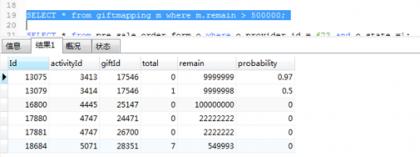日常coding当中编写出较为规范的代码,不但代码简洁美观,而已异度性强便于维护,下边十几条建议也许会让你的代码变得更加优雅。
一、MyBatis 不要为了多个查询条件而写 1 = 1
当遇到多个查询条件,使用where 1=1 可以很方便的解决我们的问题,但是这样很可能会造成非常大的性能损失
因为添加了 “where 1=1 ”的过滤条件之后,数据库系统就无法使用索引等查询优化策略,数据库系统将会被迫对每行数据进行扫描(即全表扫描) 以比较此行是否满足过滤条件,当表中的数据量较大时查询速度会非常慢;此外,还会存在SQL 注入的风险。
反例:
<select id="queryBookInfo" parameterType="com.tjt.platform.entity.BookInfo" resultType="java.lang.Integer">
select count(*) from t_rule_BookInfo t where 1=1
<if test="title !=null and title !='' ">
AND title = #{title}
</if>
<if test="author !=null and author !='' ">
AND author = #{author}
</if>
</select>
正例:
<select id="queryBookInfo" parameterType="com.tjt.platform.entity.BookInfo" resultType="java.lang.Integer">
select count(*) from t_rule_BookInfo t
<where>
<if test="title !=null and title !='' ">
title = #{title}
</if>
<if test="author !=null and author !='' ">
AND author = #{author}
</if>
</where>
</select>
UPDATE 操作也一样,可以用 标记代替 1=1。
二、迭代entrySet() 获取Map 的key 和value
当循环中只需要获取Map 的主键key时,迭代keySet() 是正确的;但是,当需要主键key 和取值value 时,迭代entrySet() 才是更高效的做法,其比先迭代keySet() 后再去通过get 取值性能更佳。
反例:
//Map 获取value 反例:
HashMap<String, String> map = new HashMap<>();
for (String key : map.keySet()){
String value = map.get(key);
}
正例:
//Map 获取key & value 正例:
HashMap<String, String> map = new HashMap<>();
for (Map.Entry<String,String> entry : map.entrySet()){
String key = entry.getKey();
String value = entry.getValue();
}
三、使用Collection.isEmpty() 检测空
使用Collection.size() 来检测是否为空在逻辑上没有问题,但是使用Collection.isEmpty() 使得代码更易读,并且可以获得更好的性能;
除此之外,任何Collection.isEmpty() 实现的时间复杂度都是O(1) ,不需要多次循环遍历,但是某些通过Collection.size() 方法实现的时间复杂度可能是O(n)
反例:
LinkedList<Object> collection = new LinkedList<>();
if (collection.size() == 0){
System.out.println("collection is empty.");
}
正例:
LinkedList<Object> collection = new LinkedList<>();
if (collection.isEmpty()){
System.out.println("collection is empty.");
}
//检测是否为null 可以使用CollectionUtils.isEmpty()
if (CollectionUtils.isEmpty(collection)){
System.out.println("collection is null.");
}
四、初始化集合时尽量指定其大小
尽量在初始化时指定集合的大小,能有效减少集合的扩容次数,因为集合每次扩容的时间复杂度很可能时O(n),耗费时间和性能。
反例:
//初始化list,往list 中添加元素反例:
int[] arr = new int[]{1,2,3,4};
List<Integer> list = new ArrayList<>();
for (int i : arr){
list.add(i);
}
正例:
//初始化list,往list 中添加元素正例:
int[] arr = new int[]{1,2,3,4};
//指定集合list 的容量大小
List<Integer> list = new ArrayList<>(arr.length);
for (int i : arr){
list.add(i);
}
五、使用StringBuilder 拼接字符串
一般的字符串拼接在编译期Java 会对其进行优化,但是在循环中字符串的拼接Java 编译期无法执行优化,所以需要使用StringBuilder 进行替换。
反例:
//在循环中拼接字符串反例
String str = "";
for (int i = 0; i < 10; i++){
//在循环中字符串拼接Java 不会对其进行优化
str += i;
}
正例:
//在循环中拼接字符串正例
String str1 = "Love";
String str2 = "Courage";
String strConcat = str1 + str2; //Java 编译器会对该普通模式的字符串拼接进行优化
StringBuilder sb = new StringBuilder();
for (int i = 0; i < 10; i++){
//在循环中,Java 编译器无法进行优化,所以要手动使用StringBuilder
sb.append(i);
}
六、若需频繁调用Collection.contains 方法则使用Set
在Java 集合类库中,List的contains 方法普遍时间复杂度为O(n),若代码中需要频繁调用contains 方法查找数据则先将集合list 转换成HashSet 实现,将O(n) 的时间复杂度将为O(1)。
反例:
//频繁调用Collection.contains() 反例
List<Object> list = new ArrayList<>();
for (int i = 0; i <= Integer.MAX_VALUE; i++){
//时间复杂度为O(n)
if (list.contains(i))
System.out.println("list contains "+ i);
}
正例:
//频繁调用Collection.contains() 正例
List<Object> list = new ArrayList<>();
Set<Object> set = new HashSet<>();
for (int i = 0; i <= Integer.MAX_VALUE; i++){
//时间复杂度为O(1)
if (set.contains(i)){
System.out.println("list contains "+ i);
}
}
七、使用静态代码块实现赋值静态成员变量
对于集合类型的静态成员变量,应该使用静态代码块赋值,而不是使用集合实现来赋值。
反例:
//赋值静态成员变量反例
private static Map<String, Integer> map = new HashMap<String, Integer>(){
{
map.put("Leo",1);
map.put("Family-loving",2);
map.put("Cold on the out side passionate on the inside",3);
}
};
private static List<String> list = new ArrayList<>(){
{
list.add("Sagittarius");
list.add("Charming");
list.add("Perfectionist");
}
};
正例:
//赋值静态成员变量正例
private static Map<String, Integer> map = new HashMap<String, Integer>();
static {
map.put("Leo",1);
map.put("Family-loving",2);
map.put("Cold on the out side passionate on the inside",3);
}
private static List<String> list = new ArrayList<>();
static {
list.add("Sagittarius");
list.add("Charming");
list.add("Perfectionist");
}
八、删除未使用的局部变量、方法参数、私有方法、字段和多余的括号
九、工具类中屏蔽构造函数
工具类是一堆静态字段和函数的集合,其不应该被实例化;
但是,Java 为每个没有明确定义构造函数的类添加了一个隐式公有构造函数,为了避免不必要的实例化,应该显式定义私有构造函数来屏蔽这个隐式公有构造函数。
反例:
public class PasswordUtils {
//工具类构造函数反例
private static final Logger LOG = LoggerFactory.getLogger(PasswordUtils.class);
public static final String DEFAULT_CRYPT_ALGO = "PBEWithMD5AndDES";
public static String encryptPassword(String aPassword) throws IOException {
return new PasswordUtils(aPassword).encrypt();
}
正例:
public class PasswordUtils {
//工具类构造函数正例
private static final Logger LOG = LoggerFactory.getLogger(PasswordUtils.class);
//定义私有构造函数来屏蔽这个隐式公有构造函数
private PasswordUtils(){}
public static final String DEFAULT_CRYPT_ALGO = "PBEWithMD5AndDES";
public static String encryptPassword(String aPassword) throws IOException {
return new PasswordUtils(aPassword).encrypt();
}
十、删除多余的异常捕获并跑出
用catch 语句捕获异常后,若什么也不进行处理,就只是让异常重新抛出,这跟不捕获异常的效果一样,可以删除这块代码或添加别的处理。
反例:
//多余异常反例
private static String fileReader(String fileName)throws IOException{
try (BufferedReader reader = new BufferedReader(new FileReader(fileName))) {
String line;
StringBuilder builder = new StringBuilder();
while ((line = reader.readLine()) != null) {
builder.append(line);
}
return builder.toString();
} catch (Exception e) {
//仅仅是重复抛异常 未作任何处理
throw e;
}
}
正例:
//多余异常正例
private static String fileReader(String fileName)throws IOException{
try (BufferedReader reader = new BufferedReader(new FileReader(fileName))) {
String line;
StringBuilder builder = new StringBuilder();
while ((line = reader.readLine()) != null) {
builder.append(line);
}
return builder.toString();
//删除多余的抛异常,或增加其他处理:
/*catch (Exception e) {
return "fileReader exception";
}*/
}
}
十一、字符串转化使用String.valueOf(value) 代替 " " + value
把其它对象或类型转化为字符串时,使用String.valueOf(value) 比 ""+value 的效率更高。
反例:
//把其它对象或类型转化为字符串反例:
int num = 520;
// "" + value
String strLove = "" + num;
正例:
//把其它对象或类型转化为字符串正例:
int num = 520;
// String.valueOf() 效率更高
String strLove = String.valueOf(num);
十二、避免使用BigDecimal(double)
BigDecimal(double) 存在精度损失风险,在精确计算或值比较的场景中可能会导致业务逻辑异常。
反例:
// BigDecimal 反例
BigDecimal bigDecimal = new BigDecimal(0.11D);
正例:
// BigDecimal 正例
BigDecimal bigDecimal1 = bigDecimal.valueOf(0.11D);
十三、返回空数组和集合而非 null
若程序运行返回null,需要调用方强制检测null,否则就会抛出空指针异常;返回空数组或空集合,有效地避免了调用方因为未检测null 而抛出空指针异常的情况,还可以删除调用方检测null 的语句使代码更简洁。
反例:
//返回null 反例
public static Result[] getResults() {
return null;
}
public static List<Result> getResultList() {
return null;
}
public static Map<String, Result> getResultMap() {
return null;
}
正例:
//返回空数组和空集正例
public static Result[] getResults() {
return new Result[0];
}
public static List<Result> getResultList() {
return Collections.emptyList();
}
public static Map<String, Result> getResultMap() {
return Collections.emptyMap();
}
十四、优先使用常量或确定值调用equals 方法
对象的equals 方法容易抛空指针异常,应使用常量或确定有值的对象来调用equals 方法。
反例:
//调用 equals 方法反例
private static boolean fileReader(String fileName)throws IOException{
// 可能抛空指针异常
return fileName.equals("Charming");
}
正例:
//调用 equals 方法正例
private static boolean fileReader(String fileName)throws IOException{
// 使用常量或确定有值的对象来调用 equals 方法
return "Charming".equals(fileName);
//或使用: java.util.Objects.equals() 方法
return Objects.equals("Charming",fileName);
}
十五、枚举的属性字段必须是私有且不可变
枚举通常被当做常量使用,如果枚举中存在公共属性字段或设置字段方法,那么这些枚举常量的属性很容易被修改;
理想情况下,枚举中的属性字段是私有的,并在私有构造函数中赋值,没有对应的Setter 方法,最好加上final 修饰符。
反例:
public enum SwitchStatus {
// 枚举的属性字段反例
DISABLED(0, "禁用"),
ENABLED(1, "启用");
public int value;
private String description;
private SwitchStatus(int value, String description) {
this.value = value;
this.description = description;
}
public String getDescription() {
return description;
}
public void setDescription(String description) {
this.description = description;
}
}
正例:
public enum SwitchStatus {
// 枚举的属性字段正例
DISABLED(0, "禁用"),
ENABLED(1, "启用");
// final 修饰
private final int value;
private final String description;
private SwitchStatus(int value, String description) {
this.value = value;
this.description = description;
}
// 没有Setter 方法
public int getValue() {
return value;
}
public String getDescription() {
return description;
}
}
十六、String.split(String regex)部分关键字需要转译
使用字符串String 的plit 方法时,传入的分隔字符串是正则表达式,则部分关键字(比如 .[]()| 等)需要转义。
反例:
// String.split(String regex) 反例
String[] split = "a.ab.abc".split(".");
System.out.println(Arrays.toString(split)); // 结果为[]
String[] split1 = "a|ab|abc".split("|");
System.out.println(Arrays.toString(split1)); // 结果为["a", "|", "a", "b", "|", "a", "b", "c"]
正例:
// String.split(String regex) 正例
// . 需要转译
String[] split2 = "a.ab.abc".split("\\.");
System.out.println(Arrays.toString(split2)); // 结果为["a", "ab", "abc"]
// | 需要转译
String[] split3 = "a|ab|abc".split("\\|");
System.out.println(Arrays.toString(split3)); // 结果为["a", "ab", "abc"]




发表吐槽
你肿么看?
既然没有吐槽,那就赶紧抢沙发吧!